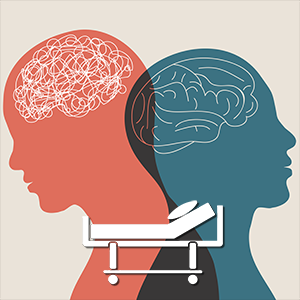Vital Sounds 2021, Quarter 3
Vital Sounds 2021, Quarter 3
The Real Cost of Boarding Psychiatric Patients in the Emergency Department: Improving Psychiatric Patient Outcomes
August 30, 2021
The Real Cost of Boarding Psychiatric Patients in the Emergency Department: Improving Psychiatric Patient Outcomes
August 30, 2021
Ashley Weber, BSN, RN, LNCC

In a recent review of medical literature, it was found that emergency department (ED) overcrowding and boarding are affecting nearly all hospital systems in the United States. Kansas EDs are not immune to this rapidly increasing phenomenon. This article outlines the costs and risks associated with boarding psychiatric patients and provides recommendations for hospital systems to improve patient outcomes.
Frequency and Cost of Boarding Psychiatric Patients in the Emergency Department
- In the U.S., 1 in 8 ED visits relates to mental health and substance use issues. This equated to a more than 44% increase in mental health and substance use ED visits between 2006 and 2014.
- ED crowding is associated with poor outcomes, including increased morbidity and mortality, delays in care, decreased patient satisfaction, longer inpatient stays, disparities in access to care for the poor and uninsured, lost hospital revenue, and missed opportunities to see additional ED patients.
- For rural hospitals, studies show the lack of available mental health services and the scarcity of qualified professionals to treat psychiatric patients result in boarding for 60% of psychiatric patients from 24 hours to 5 days.
- Many frequent ED users reported mental health conditions. These included anxiety (19%), bipolar disorder (44%), depression (25%), and schizophrenia (10%). Non-frequent users of the ED reported such histories at significantly lower rates.
- ED crowding has been linked to inadequate patient care due to prolonged wait times, delays to treatment, communication and medical errors, adverse events, and increased risk of in-hospital mortality.
- Boarding psychiatric patients in the ED comes with potential liability issues. According to a July 6, 2017 article in Modern Healthcare, a three-hospital, not-for-profit health system in South Carolina agreed to pay nearly $1.3 million to settle allegations stemming from 36 incidents that occurred between 2012 and 2013. These incidents involved holding psychiatric patients in the health system’s emergency departments (EDs) without providing appropriate psychiatric treatment. Instead of being examined and treated by on-call physicians or stabilized and treated in a psychiatric unit, the settlement says that ED physicians treated patients then kept in the ED for anywhere from 6 to 38 days. The settlement was the largest ever under the Emergency Medical Treatment and Labor Act (EMTALA).
Risks Associated With Boarding Psychiatric Patients in the Emergency Department
Potential liability exists when behavioral health patients admitted and boarded in an ED are discharged before a mental health consultant can provide an evaluation or clearance.
Studies in the literature note that providers will be less likely to be held liable if they gather as much history as possible from the patient, the patient’s family, authorities, and medical records. While comprehensive assessments are generally done by mental health consultants, such as a psychiatrist, ED physicians retain final authority over and responsibility for discharge decisions.
Recommendations to Reduce Risk
- The emergency physician can provide strong documentation of patient safety in those deemed low risk for suicide upon discharge with a robust discharge plan that includes rapid outpatient interventions.
- Once a patient is deemed a high risk for suicide, the best practice is to obtain a consultation with a trained mental health consultant prior to discharge from the ED. Consider utilizing telemedicine services if a consultation is not readily available in your area.
Solutions to Improve Psychiatric Patient Outcomes
The literature recommends four options for improving outcomes: prompt evaluation and treatment for patients with behavioral health problems, EmPATH units, additional staffing of EDs with social workers, and telehealth/telemedicine for 24/7 access to psychiatric care. Each recommendation is discussed in detail in the full research paper.
Conclusion
Improved patient outcomes:
- Aid emergency providers by freeing up much-needed ED bed space, which improves the overall flow of the ED.
- Increase patient satisfaction for all—not just psychiatric patients.
- Result in a less stressful work environment, reducing staff turnover and improving staff retention. This, in turn, decreases expenditures on staffing
- Reduce the frequency of repeat psychiatric patients using ED services, which reduces the number of psychiatric patients boarded in the ED.
- Decreases workplace violence experienced in some EDs by providing a safe and well-designed psychiatric emergency pathway.
Education is key.
